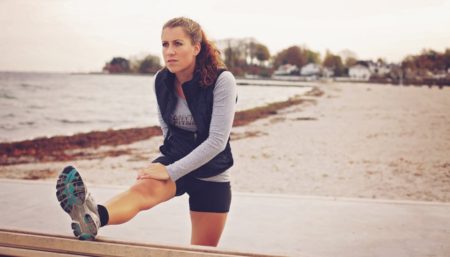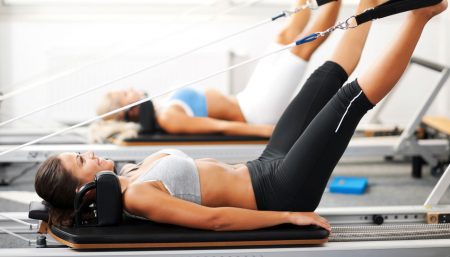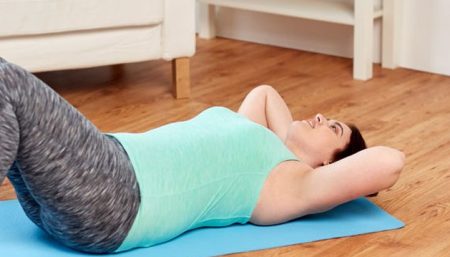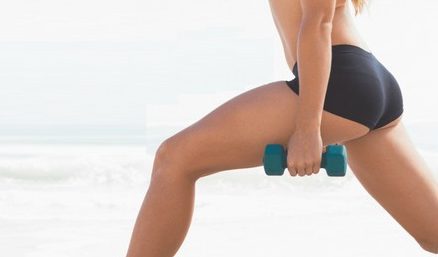
Pilates is great for shaping your body, balancing your muscles and making you more flexible. It gives attention to your stabilizing muscles, which are often ignored by other exercise styles. It does some strengthening, especially when it comes to your trunk section, but its primary purpose is not to make your legs strong.
The hips are where most females store their fat, so we’ve got some easy exercises to get that area into shape…
Hip rolls: This exercise is great for toning and stretching the waist specifically, strengthening the oblique and other rotators of the torso and stretching the back muscles. In addition to reducing the “love handles“, it will also keep your lower spine flexible!

- Lie on your back in the relaxation position with both arms out to the side and palms up.
- Bring your knees up one at a time to your chest, and put the tennis ball between your knees. Thighs at right angle to body. Pelvic neutral and Scapulas anchored.
- Breathe in and zip and hollow.
- (Breathing out): Slowly lower both legs a little toward the right and look to the left. At the same time, turn the left palm down. This will remind you to anchor your left scapula and keep it on the mat.
- Breathe in and (while breathing out): zip hard and use the “strong center” to bring your legs back to the middle. At the same time return your head to the middle and the palm of your left hand upward.
- Repeat, but this time lower both legs toward the left.
- Repeat six to eight times each side, going a little further each time.
Hip-Up: By lifting your hips, you strengthen your lower abdominal muscles (and your butt muscles as well, if you squeeze your butt on the way up). The Hip-Up can be very challenging for those with a weak tummy, a tight back, or a large lower body.

- Lie on your back with your legs up, your knees bent and your feet crossed, and your arms down by your sides.
- Rock back and lift your hips up by using your low Abdominal Scoop.
Hip Lifts: Practicing the Pilates hip lift exercise will strengthen your legs, glutes and your abdominal muscles.
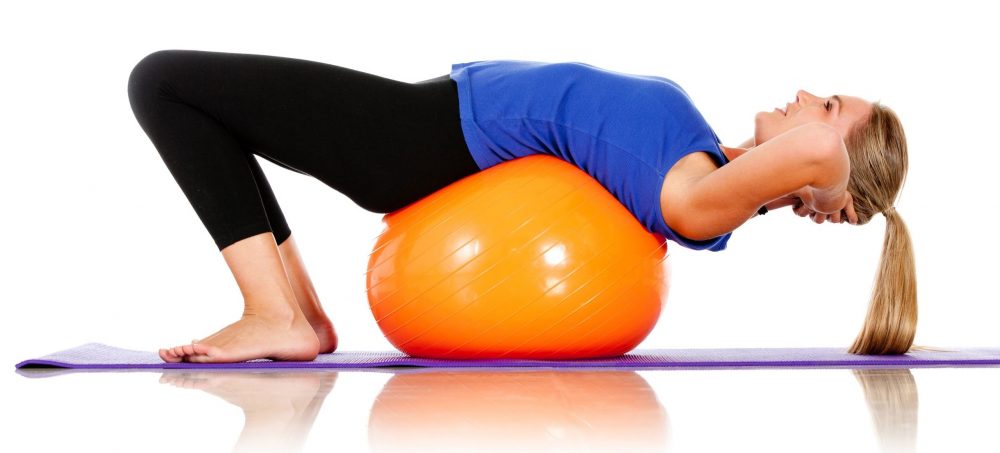
- Lie flat on the floor with your shoulders and back pressed firmly into the ground and your arms down at your sides. You may want to lie on a Pilates mat or on your carpet to be more comfortable.
- Place your ankles on top of the exercise ball with your legs straight out and slowly lift your hips until your hips and legs are aligned.
- Begin to bend your knees and slowly pull the exercise ball in toward your body, keeping your hips raised, your abs tightened and your feet on the ball. Inhale while you’re pulling the ball in toward you.
- Exhale and slowly push the ball back out. Make sure to straighten your legs again and reach your initial position with your hips raised off the ground and your ankles resting on top of the ball.
- Repeat this exercise at least 10 times, inhaling while rolling the ball in toward you, and exhaling each time you push the ball back out again.
Hip rotator: The Pilates hip rotator stretch is used to ensure maximum range and strength throughout the whole movement of the hips.
- Stand square to a wall with a flat surface about hip height strong enough to hold the weight of your leg.
- Place your left leg up on the object with the foot in a vertical alignment. Ensure that your hips are vertically aligned properly and stomach tight to force correct posture.
- Take a deep breath. While exhaling slowly rotate your whole leg so that the ankle turns anti-clockwise to the end of its range. The anti clockwise movement will rotate the hip externally for the left leg.
- Hold the position and take another deep breath.
- While slowly exhaling rotate the leg further, you can use your hands to increase the amount that the leg rotates.
- Repeat this until you have taken ten breaths.
- Repeat the above rotating clockwise. This will have the same effect for the internal rotation.
- Repeat for the right leg, obviously this will mirror the stretch for the left.
Standing Side Kicks: This hip exercise improves balance while stretching and strengthening the hips and thighs.

- Standing tall with feet together abs engaged and ribs lifted up off the pelvis.
- Standing tall on your right leg with hips evenly aligned, swing the left leg straight out to the side. Do not lean to make the leg go higher, it will feel like it just stops at one point.
- Then swing the heel back in front of the other foot and repeat out to the side for 8-10 repetitions.
- Repeat on the other side.
Lying Side Kick: When balancing on the smaller surface area of your side, your core stabilizer (abdominal) muscles and your hip muscles are forced to work harder. The following exercise is a movement that targets the top hip joint, and strengthens the muscles of the outside and back of the hip. It can be conducted in sets of 8 to 10 repetitions for each side:
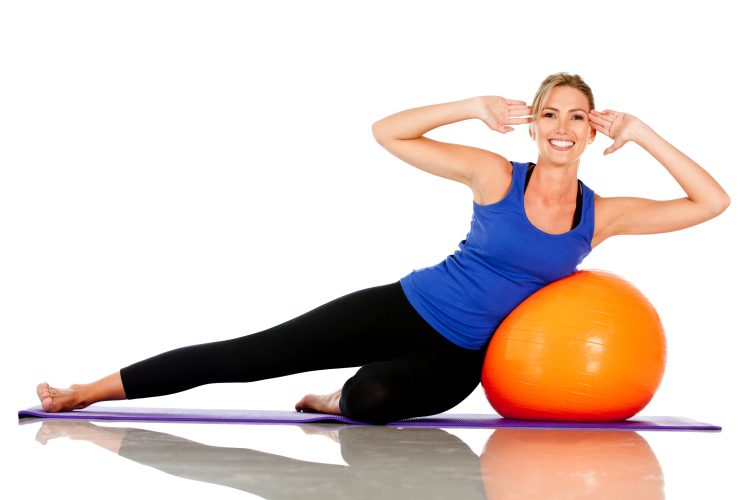
- Lie on your side with your bottom leg bent forward and forming a 90 degree angle. Your top leg should be straight and directly below your hip.
- While breathing in, keep the top leg straight and rotate it clockwise as far as you can move it. Hold this position.
- While breathing out, point your top foot and sweep the top leg back into its original position, without distributing the position of your pelvis and spine.
The Clam : Pelvic stability will result in greater hip joint mobility, greater hip tone, and better-toned thigh muscles. The following exercise can be conducted in sets of 10 to 15 repetitions for each leg:
- Lie on your side with your knees bent and your feet in line with your spine. Place your head on a pillow.
- While exhaling, keep your together and lift your top knee in an arc, without moving your pelvis.
- While inhaling, slowly lower your upper leg.
Cushion Squeeze: Pelvic stability will result in greater hip joint mobility, greater hip tone, and better-toned thigh muscles. The following exercise can be conducted in sets of 4 to 5 repetitions:
- Lie on your back with your legs bent and feet face-down on the floor so that you are in the preparatory position. Place a cushion between your knees. Breath-in and focus contracting your abdominals.
- While breathing out, squeeze your thighs together without moving your pelvis. Elongate your breath so that the squeezing lasts for a count of 5.
- While breathing in, release the pillow in 5 counts. While releasing the pillow, ensure that your abdominal muscles are still being applied inwards.
Tip: One of the reason we all have such tight hip flexors is because we sit for such a large portion of the day. When you sit you place your hip flexors in a shortened position and if they’re held in that shortened position for hours on end (say, at your computer), when you try to stand up they have a hard time lengthening. So take breaks from sitting!
Disclaimer
The Content is not intended to be a substitute for professional medical advice, diagnosis, or treatment. Always seek the advice of your physician or other qualified health provider with any questions you may have regarding a medical condition.
